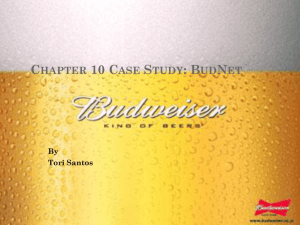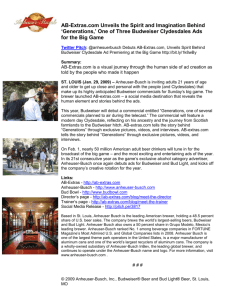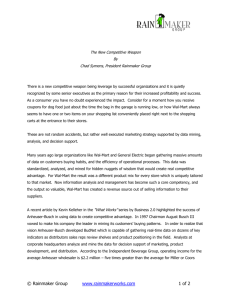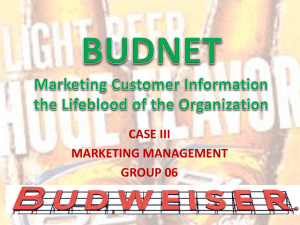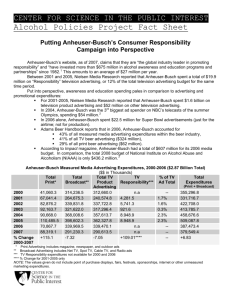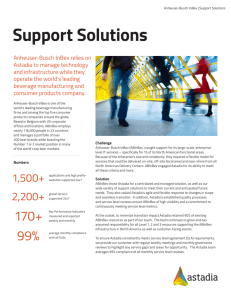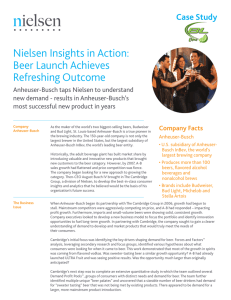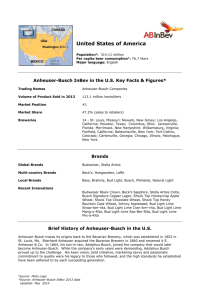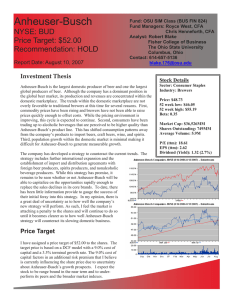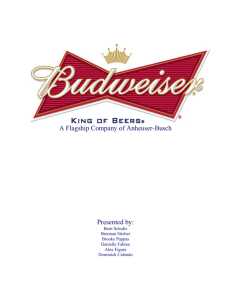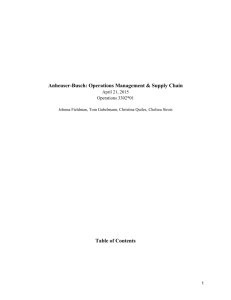Anheuser-Busch Companies Incorporated is primarily considered a
advertisement
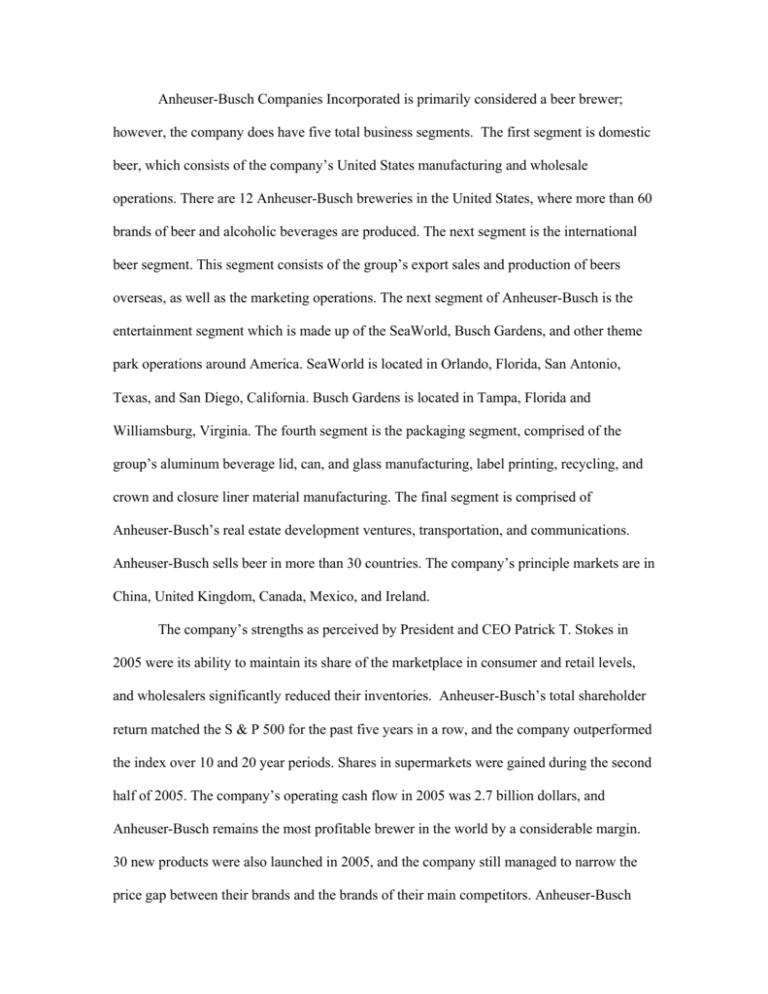
Anheuser-Busch Companies Incorporated is primarily considered a beer brewer; however, the company does have five total business segments. The first segment is domestic beer, which consists of the company’s United States manufacturing and wholesale operations. There are 12 Anheuser-Busch breweries in the United States, where more than 60 brands of beer and alcoholic beverages are produced. The next segment is the international beer segment. This segment consists of the group’s export sales and production of beers overseas, as well as the marketing operations. The next segment of Anheuser-Busch is the entertainment segment which is made up of the SeaWorld, Busch Gardens, and other theme park operations around America. SeaWorld is located in Orlando, Florida, San Antonio, Texas, and San Diego, California. Busch Gardens is located in Tampa, Florida and Williamsburg, Virginia. The fourth segment is the packaging segment, comprised of the group’s aluminum beverage lid, can, and glass manufacturing, label printing, recycling, and crown and closure liner material manufacturing. The final segment is comprised of Anheuser-Busch’s real estate development ventures, transportation, and communications. Anheuser-Busch sells beer in more than 30 countries. The company’s principle markets are in China, United Kingdom, Canada, Mexico, and Ireland. The company’s strengths as perceived by President and CEO Patrick T. Stokes in 2005 were its ability to maintain its share of the marketplace in consumer and retail levels, and wholesalers significantly reduced their inventories. Anheuser-Busch’s total shareholder return matched the S & P 500 for the past five years in a row, and the company outperformed the index over 10 and 20 year periods. Shares in supermarkets were gained during the second half of 2005. The company’s operating cash flow in 2005 was 2.7 billion dollars, and Anheuser-Busch remains the most profitable brewer in the world by a considerable margin. 30 new products were also launched in 2005, and the company still managed to narrow the price gap between their brands and the brands of their main competitors. Anheuser-Busch also has many opportunities for 2006 and beyond. There are many new products being developed and tested in the consumer markets. Anheuser-Busch also sells 2.5 times as much beer as their closest competitor, which allows them to maintain the leading voice in advertising, which includes a powerful array of sporting events and media properties while still maintaining the lowest media cost per barrel produced. The 12 breweries around the United States also provide advantages in shipping in distribution. Anheuser-Busch beer at retail is at least two weeks fresher than the beers of competitors. Anheuser-Busch Companies Incorporated did have some weaknesses in 2005 as well. When the year 2005 began, domestic market shares were declining. Wine and hard liquor were increasing their shares of the alcoholic beverage market. Also, the rising cost of energy and raw materials were cutting into the company’s profit margins. To combat these declines, Anheuser-Busch decided to reduce their price premium to their competitors’ levels, create new and innovative packaging to promote sales, realign the market behind major brands like Budweiser, Michelob, and Bud Light. The company also decided to freeze the salaries of officers in 2006, cut health care benefits for employees, as well as eliminating bonuses for corporate and beer business employees in 2005. According to an article from the American Medical Association, titled “Alcohol Industry 101: Its Structure and Organization” Anheuser-Busch has tried to take and maintain control of the company at all levels, also known as vertical integration. The article claims that Anheuser-Busch markets competition among beers of the same parent company, namely: Bud Light, Budweiser, Bud Ice, and Budweiser Select. This creates the appearance of diversity in various markets, with low-end and high-end brands seeming to compete against each other. The article also says that Anheuser-Busch no longer allows its distributors to carry any other products besides its own, and cites various high-profile legal battles Anheuser-Busch has been involved in for the past 10 years. The article also states the retail sales of beer in general as generating more than 74.4 billion dollars in retail sales and says that at the end of 2003, Anheuser-Busch has experienced 16 straight quarters of earningsper- share growth and had over 50 percent of the domestic market share. The article also provides a chart of the 2002 31 gallon beer barrel sales, with Anheuser-Busch coming in first place at 101,800,000 sold, and Miller breweries coming in second at only 39,660,000 barrels sold. Anheuser-Busch also has five out of the top 10 beer brands sold in 2002, with Bud Light and Budweiser coming in first and second place. The article also goes on to list the sporting events sponsored by Anheuser-Busch. The company sponsors the World Cup, Ladies Professional Golf Association, Major League Baseball, Major League Soccer, NASCAR, the National Basketball Association, the National Football League, the National Hockey League, the Professional Golfers’ Association, and the Women’s National Basketball Association. Anheuser-Busch was also the first brewery to sponsor a national television show and started sponsoring concerts in 2002 where attendees could only gain tickets to the concerts through Budweiser. Lastly, the article discusses Anheuser-Busch’s $40 million “Responsible Drinking” campaign which the company launched in 1999, which focuses on re-enforcing the responsibility of retailers, parents, and designated drivers but criticizes the campaign for not mentioning exactly “when” to quit drinking.
